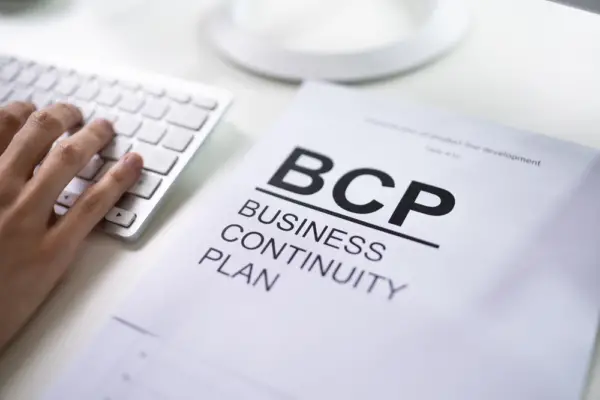A business continuity plan (BCP) is a comprehensive strategy that outlines how a company will continue to operate during an unplanned service disruption.
BCPs are designed to ensure that essential business functions can continue during and after a disaster, such as a natural disaster, cyber-attack, or power outage.
The goal of a BCP is to minimize the impact of a disruption on a company’s operations, customers, and employees.
The primary goal of a business continuity plan is to provide a framework for responding to a disaster or other unplanned event that disrupts normal business operations.
This framework should include detailed procedures for restoring essential business functions, communication plans for keeping employees, customers, and stakeholders informed, and contingency plans for dealing with any unexpected issues that arise during the recovery process.

A well-designed BCP can help a company minimize the impact of a disaster on its operations, avoid costly downtime, and maintain its reputation and customer base.
The goal of a business continuity plan is to ensure that a company can continue to operate during and after a disaster by providing a framework for responding to disruptions in service.
By developing a comprehensive BCP, companies can minimize the impact of a disaster on their operations, maintain their reputation and customer base, and avoid costly downtime.
Understanding Business Continuity Planning
Business continuity planning (BCP) is a process that helps organizations prepare for and respond to disruptive events that may impact their operations.
The purpose of BCP is to ensure that an organization can continue to operate during and after a disruption, with minimal impact on its reputation, customers, and clients.
Definition and Purpose
BCP is a proactive approach to risk management that involves identifying potential risks and developing strategies to mitigate them.
The goal of BCP is to minimize the impact of a disruptive event on an organization’s operations and to ensure that it can continue to provide goods and services to its customers and clients.
Importance of Business Continuity
Business continuity is essential for organizations of all sizes and types. Disruptive events can include natural disasters, cyber-attacks, power outages, and other unforeseen circumstances that can damage an organization’s reputation and financial stability.
A well-designed BCP can help an organization minimize the impact of a disruptive event on its operations, customers, and clients.
It can also help an organization recover quickly and resume normal operations as soon as possible.
The objectives of BCP may include protecting the safety of personnel, minimizing financial losses, maintaining business continuity, and ensuring that critical operations can be restored quickly.
By developing a comprehensive BCP, organizations can improve their resilience and ability to respond to disruptive events.
Components of a Business Continuity Plan
A Business Continuity Plan (BCP) is a comprehensive document that outlines the procedures an organization must follow in the event of a disaster or other disruptive event.
A BCP is designed to ensure that critical business functions can continue to operate in the face of unexpected disruptions. The components of a BCP include:
Business Impact Analysis (BIA)
A BIA is a critical component of a BCP. It involves identifying and analyzing the potential impact of a disaster on an organization’s critical business functions.
The BIA should identify the financial impact of a disaster, the recovery time objective for each critical function, and the essential functions that must be restored first.
Recovery Strategies
Recovery strategies are the plans that an organization puts in place to restore critical business functions after a disaster.
Recovery strategies should be designed to minimize the financial impact of a disaster and to ensure that critical functions can be restored as quickly as possible.
Plan Development
Plan development involves designing a BCP that is tailored to an organization’s specific needs.
This includes creating templates and protocols for responding to a disaster, as well as identifying the personnel who will be responsible for implementing the plan.
Testing and Maintenance
Regular testing and maintenance are essential to ensure that a BCP is effective. Testing should be conducted to identify any weaknesses in the plan and to ensure that personnel are familiar with their roles and responsibilities.
The BCP should be updated regularly to reflect changes in the organization’s critical business functions or operations.
A BCP is a critical component of an organization’s disaster preparedness plan. The components of a BCP include a business impact analysis, recovery strategies, plan development, and testing and maintenance.
By having a well-designed and regularly tested BCP in place, organizations can ensure that critical business functions can continue to operate in the face of unexpected disruptions.
Key Elements of Business Continuity
A business continuity plan (BCP) is a documented plan that outlines how an organization will continue to operate during and after a crisis or emergency.
A BCP is an essential part of an organization’s overall risk management strategy. The goal of a BCP is to help an organization prepare for and respond to a crisis or emergency and to minimize the impact of the crisis on the organization’s operations, employees, and clients.

Crisis Management and Response
The crisis management and response section of a BCP outlines the steps that an organization will take to manage a crisis or emergency.
This section should include a detailed plan for responding to the crisis, including an emergency response plan, a communication plan, and a plan for coordinating with external agencies and organizations.
The emergency response plan should outline the steps that the organization will take to respond to the crisis.
This plan should include procedures for evacuating the building, contacting emergency services, and providing first aid to injured employees or clients.
Communication Plan
The communication plan section of a BCP outlines how the organization will communicate with its employees, clients, and external stakeholders during a crisis or emergency.
This section should include a list of key contact information for employees, clients, and external stakeholders, including emergency contact information.
The communication plan should also include procedures for communicating with employees, clients, and external stakeholders during a crisis or emergency.
This may include using social media, email, or other forms of communication to keep stakeholders informed about the situation.
Roles and Responsibilities
The roles and responsibilities section of a BCP outlines the responsibilities of the continuity team, staff, and personnel during a crisis or emergency.
This section should include a list of key personnel and their roles and responsibilities during a crisis or emergency.
The roles and responsibilities section should also include procedures for activating the continuity team and for ensuring that all staff and personnel are aware of their roles and responsibilities during a crisis or emergency.
BCP is an essential part of an organization’s overall risk management strategy. The key elements of a BCP include crisis management and response, a communication plan, and roles and responsibilities.
By having a well-documented BCP, an organization can prepare for and respond to a crisis or emergency and minimize the impact of the crisis on its operations, employees, and clients.
Risk Assessment and Management
A key goal of a business continuity plan is to identify and manage potential risks that could impact the organization’s ability to operate.
Risk assessment is a critical component of this process, as it helps to identify potential threats and vulnerabilities, and develop strategies to mitigate them.
Identifying Potential Threats
The first step in risk assessment is to identify potential threats to the organization. These threats can come from a variety of sources, including natural disasters, pandemics, cyber-attacks, and other security breaches.
It is important to consider all potential threats, as well as their likelihood and potential impact on the organization.
Vulnerability Analysis
Once potential threats have been identified, the next step is to conduct a vulnerability analysis.
This involves assessing the organization’s infrastructure, IT infrastructure, and other systems to identify weaknesses and vulnerabilities that could be exploited by a potential threat.
This analysis should also consider the potential impact of a threat on the organization’s operations and reputation.
Security and Protection Measures
The final step in risk assessment is to develop strategies to mitigate potential threats and vulnerabilities.
This may involve implementing security and protection measures, such as firewalls, antivirus software, and data encryption.
It may also involve developing contingency plans to ensure that critical business functions can continue in the event of a disruption.
Risk assessment and management are critical components of a business continuity plan.
By identifying potential threats, and vulnerabilities, and developing strategies to mitigate them, organizations can ensure that they are prepared to respond to any disruption that may occur.

Operational Resilience and Recovery
A business continuity plan (BCP) is a comprehensive plan that outlines how a company will continue to operate during and after a disaster or other disruptive event.
The goal of a BCP is to ensure that critical business functions can continue with minimal disruption and that the company can recover as quickly as possible.
Continuity of Critical Functions
One of the primary goals of a BCP is to ensure the continuity of critical business functions.
These functions are typically identified as those that are essential to the company’s ability to generate revenue, maintain operations, and meet customer needs.
Examples of critical business functions may include supply chain management, manufacturing, and customer service.
IT and Data Recovery
IT services and data centers are often critical to the operation of a business, and a BCP should include plans for IT and data recovery.
This may involve backing up data and systems, identifying alternative systems and providers, and testing the recovery process to ensure that it works as intended.
Employee Safety and Well-Being
In addition to ensuring the continuity of critical business functions, a BCP should also prioritize the safety and well-being of employees.
This may involve providing training on emergency procedures, ensuring that employees have access to necessary resources such as food and water, and identifying safe locations for employees to shelter during a disaster.
A BCP should be a comprehensive plan that covers all aspects of a company’s operations and ensures that the company can recover as quickly as possible in the event of a disaster or other disruptive event.
By prioritizing the continuity of critical business functions, IT and data recovery, and employee safety and well-being, a BCP can help a company maintain operational resilience and recover from disruptions with minimal impact.
Training and Awareness
Training and awareness are critical components of a business continuity plan. Without proper training, staff may not be able to execute the plan effectively, and the organization may not be able to recover from a disaster.
As such, training should be an ongoing process that involves all members of the organization, from top management to front-line employees.
One way to ensure staff are well-prepared and knowledgeable about the BCP plan is to conduct regular training sessions.
These sessions should cover all aspects of the plan, including roles and responsibilities, communication protocols, and recovery procedures.
Training should be tailored to fit specific business models and industries and should be conducted in a way that is engaging and interactive.
Another important aspect of training is lessons learned. After a disaster, it is important to review the effectiveness of the BCP plan and identify areas for improvement.
This review should be conducted in a non-judgmental and constructive manner and should involve all members of the organization who were involved in the response effort.
By learning from past experiences, the organization can improve its BCP plan and increase its chances of success in the future.
In addition to training, awareness is also critical for the success of a BCP plan. Staff should be aware of the potential risks and threats facing the organization, and should understand the importance of the BCP plan in mitigating these risks.
Awareness can be increased through regular communication and education, such as newsletters, posters, and email updates.
Training and awareness are essential components of a successful BCP plan. By ensuring staff are well-prepared and knowledgeable, and by learning from past experiences, organizations can increase their resilience and recover more quickly from disasters.
Legal and Compliance Considerations
Business continuity planning is not only a good business practice but also a legal and compliance requirement for many organizations.
In some industries, such as healthcare, finance, and government, having a business continuity and compliance plan is mandatory, and non-compliance can lead to severe penalties.
Therefore, organizations must understand the legal and compliance considerations involved in developing a business continuity plan.
One of the primary legal considerations for business continuity planning is compliance with regulations. Organizations must ensure that their business continuity plan complies with the relevant laws and regulations.
For example, in the healthcare industry, the Health Insurance Portability and Accountability Act (HIPAA) requires covered entities to have a contingency plan that includes disaster recovery and emergency operations.
Similarly, in the financial services industry, the Federal Financial Institutions Examination Council (FFIEC) requires financial institutions to have a business continuity plan that includes testing, training, and maintenance.
Another legal consideration for business continuity planning is insurance. Organizations must ensure that their business continuity plan is adequately covered by insurance.
This includes ensuring that the insurance policies cover the potential losses and damages that can arise from a disaster or disruption. Organizations should also ensure that their insurance policies comply with the relevant laws and regulations.
Compliance is another critical consideration for business continuity planning. Organizations must ensure that their business continuity plan complies with the relevant compliance standards.
Compliance standards can vary depending on the industry, but some common compliance standards include the International Organization for Standardization (ISO) 22301, National Institute of Standards and Technology (NIST) Special Publication 800-34, and the Business Continuity Institute’s Good Practice Guidelines.
Legal and compliance considerations are critical for developing a business continuity plan. Organizations must ensure that their plan complies with the relevant laws, regulations, and compliance standards.
They must also ensure that their plan is adequately covered by insurance. By doing so, organizations can minimize the risks associated with a disaster or disruption and ensure that they can continue their operations in the event of a crisis.
Plan Implementation and Execution
Once the business continuity plan has been developed and tested, it is time to implement and execute it.
This section covers the key elements of plan implementation and execution.
Activation Protocols
Activation protocols are the procedures that are followed when the business continuity plan is activated.
These protocols should include a clear schedule of events that are triggered by specific events or incidents.
The schedule should be developed in consultation with key stakeholders and should be reviewed and updated regularly.
Resource Management
Resource management is a critical aspect of plan implementation and execution. This involves identifying the resources that are required to implement the plan and ensuring that they are available when needed.
This includes everything from emergency management teams and crisis communication systems to physical assets and IT infrastructure.
It is important to have a clear checklist of all the resources that are required and to ensure that they are available and ready to use.
Recovery and Restoration Procedures
Recovery and restoration procedures are the processes that are followed to recover and restore business operations following an incident or crisis.
This includes business recovery, relocation, and the restoration of IT systems and infrastructure. It is important to have clear procedures in place to ensure that the recovery and restoration process is as smooth and efficient as possible.
The implementation and execution of a business continuity plan requires careful planning, preparation, and coordination.
By following a clear schedule of events, ensuring that all resources are available, and having clear recovery and restoration procedures in place, businesses can minimize the impact of a crisis and ensure that they can continue operating even in the face of adversity.

Monitoring and Reviewing
Monitoring and reviewing are critical components of a business continuity plan. It is important to monitor the plan to ensure that it is being implemented as intended and that any necessary adjustments are made.
This helps to ensure that the plan remains relevant and effective over time.
One way to monitor the plan is through the use of checklists. Checklists can be used to ensure that all necessary steps are being taken and that nothing is overlooked. They can also be used to identify areas where improvements can be made.
Another important aspect of monitoring and reviewing is the use of a framework. A framework provides a structure for the plan and helps to ensure that all necessary components are included.
It also helps to ensure that the plan is consistent with industry standards and best practices.
Regular reviews of the plan are also important. Reviews should be conducted at least annually, and more frequently if there are any significant changes to the organization or its environment.
Reviews should be conducted by a team of individuals who are familiar with the plan and its objectives.
During the review process, it is important to identify any weaknesses or gaps in the plan and to take steps to address them.
This may involve updating the plan, revising procedures, or providing additional training to employees.
Monitoring and reviewing are critical components of a business continuity plan. By regularly monitoring the plan and conducting reviews, organizations can ensure that their plan remains effective and relevant over time.
Improving and Updating the Plan
Business continuity plans are not static documents, but rather a living process that must be regularly updated.
The process of improving and updating the plan should be based on lessons learned from previous disruptions, new knowledge about the business, and changes in the business environment.
One way to improve and update the plan is to conduct regular reviews and testing. This ensures that the plan is current and relevant and that all stakeholders understand their roles and responsibilities in the event of a disruption.
Regular reviews can also identify areas for improvement and allow for the incorporation of new knowledge and best practices.
Another way to improve and update the plan is to incorporate lessons learned from previous disruptions.
This includes identifying what worked well and what did not, and using that knowledge to improve the plan.
For example, if a disruption revealed a gap in the plan, such as a lack of redundancy in critical systems, that gap should be addressed in the updated plan.
Updating the plan also involves incorporating new knowledge about the business and changes in the business environment.
For example, if the business expands into new markets or introduces new products, the plan should be updated to reflect those changes.
Similarly, if there are changes in the regulatory environment or in the threat landscape, the plan should be updated to reflect those changes.
Improving and updating the business continuity plan is an ongoing process that involves regular reviews and testing, incorporating lessons learned from previous disruptions, and incorporating new knowledge about the business and changes in the business environment.
By taking a proactive approach to updating the plan, businesses can ensure that they are prepared to respond to disruptions and maintain critical operations.
Frequently Asked Questions
What are the core objectives of implementing a business continuity plan?
The primary goal of implementing a business continuity plan (BCP) is to ensure that an organization can continue to operate during and after a disruptive event.
The core objectives of BCP include increasing resilience against disruption, protecting sales, production, employees, and customers, and minimizing the impact of a disaster on the business.
How does a business continuity plan differ from a disaster recovery plan?
While the terms business continuity and disaster recovery are closely related, they are different.
Typically, disaster recovery is associated with the technology function of a business. Disaster recovery plans focus on restoring technology infrastructure and data after a disruptive event.
On the other hand, business continuity plans focus on the entire business, including people, processes, and technology, to ensure that the business can continue to operate during and after a disruptive event.
What are the key elements typically included in a business continuity plan?
A business continuity plan typically includes the following key elements:
- Risk Assessment.
- Business Impact Analysis.
- Recovery Strategies.
- Plan Development.
- Testing and Training.
- Maintenance and Review.
What is the significance of defining the scope and purpose in a business continuity plan?
Defining the scope and purpose of a business continuity plan is essential to ensure that the plan is tailored to the specific needs of the organization.
The scope defines the boundaries of the plan, including the departments, processes, and systems covered, while the purpose outlines the objectives and goals of the plan.
How does a business continuity plan ensure the resumption of critical operations post-disaster?
A business continuity plan ensures the resumption of critical operations post-disaster by providing a roadmap for recovery.
The plan outlines the steps required to restore critical business functions, including processes, systems, and data.
The plan also identifies the roles and responsibilities of key personnel and outlines communication protocols to ensure that everyone is informed and working together towards the same goal.
What are some examples of minimum objectives for business continuity?
Some examples of minimum objectives for business continuity include:
- Ensuring the safety of employees and customers.
- Minimizing financial loss.
- Maintaining business operations.
- Protecting the organization’s reputation.
- Complying with legal and regulatory requirements.

Chris Ekai is a Risk Management expert with over 10 years of experience in the field. He has a Master’s(MSc) degree in Risk Management from University of Portsmouth and is a CPA and Finance professional. He currently works as a Content Manager at Risk Publishing, writing about Enterprise Risk Management, Business Continuity Management and Project Management.

